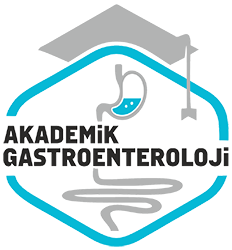Aralik 2022
Parkinson hastalarinda perkütan endoskopik gastrojejunostomi katateri takilan hastalarimizin takibi: Tek merkez deneyimi
Follow-up of the patients with percutaneous endoscopic gastrojejunustomy catheter placements in Parkinson’s disease: A single center experience
- Ana Sayfa
- Sayılar
- Aralik 2022
- Parkinson hastalarinda perkütan endoskopik gastrojejunostomi katateri takilan hastalarimizin takibi: Tek merkez deneyimi...
Özet
Giriş ve Amaç: Perkütan endoskopik gastrostomi ve perkütan endoskopik gastrojejunostomi enteral nutrisyonda sik kullanılan yöntemlerdir. Son yıllarda ileri evre Parkinson hastalığı tedavisinde, Levodopa/Karbidopa intestinal jel, perkütan endoskopik gastrojejunostomi ile uygulanmaktadır. Biz, burada Parkinson hastalığı tedavisi için pull teknigi ile perkütan endoskopik gastrojejunostomi katateri yerlestirilen hastalarimizin takiplerini sunmayi amaçladık. Gereç ve Yöntem: Mayis 2019 - Mart 2022 yıllari arasında perkütan endoskopik gastrojejunostomi takilan 11 hasta incelendi, hastalara ait demografik veriler, islem sonrasi komplikasyonlari ve islem tekrarlari değerlendirildi. Bulgular: Perkütan endoskopik gastrojejunostomi takilan Hastaların 1’i (%9) kadın, 10’u erkek (%91), yaş ortalaması 63.5 ± 11.2 olup en genç hasta 43 ve en yaşli hasta 78 yaşindaydi. Onbir hastaya perkütan endoskopik gastrojejunostomi takilmasi, perkütan endoskopik gastrostomi ve jejunal tüp degisimi olmak üzere toplam 23 endoskopik islem uygulandi. Ilk perkütan endoskopik gastrojejunostomi takilmasi sonrasinda perkütan endoskopik gastrojejunostomi seti ve/veya sadece jejunal katater replasmani arasındaki ortalama süre 310.5 ± 252.3 gün iken en kisa süre 60 gün, en uzun süre 674 gündü. Replasmanlar arasındaki en kisa süre 26 gün iken, en uzun süre 641 gündü. Hiçbir hastada akut ya da majör komplikasyon görülmezken, jejunal katater tikanmasi (3’ü ilaç ile, 1’i king olmasi) %28.5 oraninda en fazla görülen minör komplikasyon olmuştur. Bunu sırasıyla %21.4 (3 olgu) stoma enfeksiyonu, %14.2 (2 hasta) perkütan endoskopik gastrostomi asinmasi, %14.2 (2 hasta) jejunal tüpün yanlislikla çekilmesi, %7.1 perkütan endoskopik gastrostomi tikanmasi (n=1) ve %7.1 (n=1) perkütan endoskopik gastrojejunostomi setinin çekilmesi izlemıştır. Ondört adet toplam advers olay bildirilmıştır. Sonuç: Perkütan endoskopik gastrojejunostomi yerlestirme ve degistirmesi güvenli bir prosedürdür, ancak perkütan endoskopik gastrojejunostominin uzun süreli kullanımini ve dayanikliligini arastiran çok az veri bulunmaktadır, replasman için en iyi zamani ve uzun süreli klinik sonuçları gösteren prospektif çalışmalara ihtiyaç vardır
Abstract
Background and Aims: Percutaneous endoscopic gastrostomy and percutaneous endoscopic gastrojejunostomy are frequently used methods in enteral nutrition. In recent years, in the treatment of advanced Parkinson’s disease Levodopa/Carbidopa intestinal gel is given with percutaneous endoscopic gastrojejunostomy. In this study we aimed to present the follow-up of our patients who had percutaneous endoscopic gastrojejunostomy catheter. Materials and Method: Eleven patients who underwent percutaneous endoscopic gastrojejunostomy placement between March 2019 - May 2022 were examined, demographic data of the patients, complications after the procedure, and procedure repetitions were evaluated. Results: One (9%) of the patients with percutaneous endoscopic gastrojejunostomy were female and 10 were male, mean age was 63.5 ± 11.2 years, the youngest patient was 43 years old, and the oldest was 78 years old. We performed a total of 23 procedures. The mean time between percutaneous endoscopic gastrojejunostomy placement and/or jejunal tube replacement after the first percutaneous endoscopic gastrojejunostomy insertion was 310.5 ± 252.3 days, while the shortest time was 60 days and the longest was 674 days. The shortest time between replacements was 26 days, while the longest was 641 days. Although no serious or major adverse event related to the procedure was observed in any patients, jejunal-catheter occlusion (3 with medication, 1 with king) was the most common minor complication with a rate of 28.5%, followed by stoma infection in 21.4% (n: 3), 14.2% (n: 2) percutaneous endoscopic gastrostomy abrasion, 14.2% (n: 2) accidental removal of jejunal tube, 7.1% percutaneous endoscopic gastrostomy occlusion (n: 1) and 7.1% (n: 1) percutaneous endoscopic gastrojejunostomy set withdrawal. A total of fourteen adverse events were reported. Conclusion: Percutaneous endoscopic gastrojejunostomy placement and replacement are safe procedures, but there isn’t any enough data investigating the long-term use and durability of percutaneous endoscopic gastrojejunostomy, prospective studies are needed to demonstrate the best timing for replacement and long-term clinical outcomes



